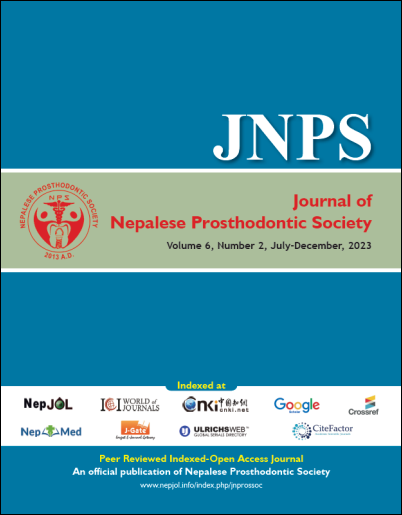An Evaluation of the Curve of Spee in the Maxilla and Mandible of Human Permanent Healthy Dentitions: A Cross Sectional Analytical Study in a Group of Nepalese Population
DOI:
https://doi.org/10.3126/jnprossoc.v6i2.64702Keywords:
Radius, Depth, Curve of Spee, Cuspid, Compensating curvesAbstract
Introduction: Familiarity with the typical measurements of the maxillary and mandibular curves of Spee can assist clinicians in formulating sagittal plane occlusion and proves beneficial in delivering prosthetic rehabilitation for patients with occlusal derangement. The objective of this study is to evaluate and compare the radius and depth of the Spee curve in the maxillary and mandibular arches among both male and female individuals within young Nepalese population.
Materials and Methods: The study comprised 21 men and 21 women aged between 18 and 30 years. Alginate impressions were made for both the maxillary and mandibular arches and dental stone casts were subsequently created. Digital images of the right side of maxillary and mandibular dental casts were captured using a digital camera and subsequently transferred to a computer. The tips of the distal cusps of molars, premolars, and canines in both the maxillary and mandibular arches were identified. Utilizing the computer software (Corel DRAW), the radius and depth of the Spee curve were measured based on the digital photographs of the dental casts.
Results: The results indicated a substantial difference in the depth of the Spee curve between the mandibular and maxillary arches (p<0.001), with the mandibular arch displaying a significantly greater depth. Furthermore, the Spee curve was notably deeper in females (p=0.045) compared to males. However, there was no statistically significant difference in the depth of the Spee curve in the mandible between genders (p=0.171).
Conclusions: The radius of the Spee curve was unaffected by the gender or arch of the subjects under investigation. Nevertheless, the Spee curve was observed to be significantly flatter in the maxillary arch when contrasted with the mandibular arch. Additionally, a notable difference in the depth of the Spee curve was identified between females and males, with females displaying a greater depth.
Downloads
Downloads
Published
How to Cite
Issue
Section
License
Copyright (c) 2023 The Author(s)

This work is licensed under a Creative Commons Attribution-NonCommercial-NoDerivatives 4.0 International License.
This license enables reusers to distribute, remix, adapt, and build upon the material in any medium or format, so long as attribution is given to the creator. The license allows for commercial use. © The authors




